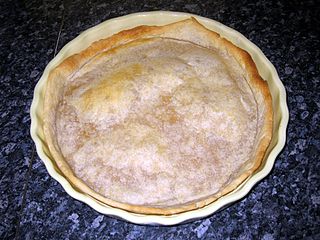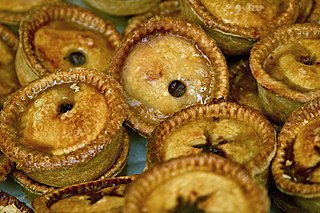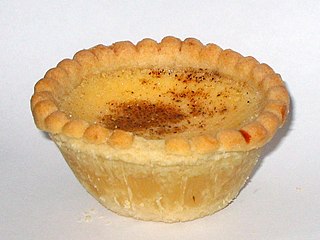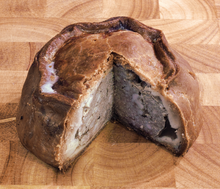
Shortcrust pastry is a type of pastry often used for the base of a tart, quiche, pie, or flan. Shortcrust pastry can be used to make both sweet and savory pies such as apple pie, quiche, lemon meringue or chicken pie.

Cake is a flour confection made from flour, sugar, and other ingredients, and is usually baked. In their oldest forms, cakes were modifications of bread, but cakes now cover a wide range of preparations that can be simple or elaborate, and which share features with desserts such as pastries, meringues, custards, and pies.

Pastry is baked food made with a dough of flour, water and shortening that may be savoury or sweetened. Sweetened pastries are often described as bakers' confectionery. The word "pastries" suggests many kinds of baked products made from ingredients such as flour, sugar, milk, butter, shortening, baking powder, and eggs. Small tarts and other sweet baked products are called pastries as a synecdoche. Common pastry dishes include pies, tarts, quiches, croissants, and pasties.

A pie is a baked dish which is usually made of a pastry dough casing that contains a filling of various sweet or savoury ingredients. Sweet pies may be filled with fruit, nuts, brown sugar, sweetened vegetables, or with thicker fillings based on eggs and dairy. Savoury pies may be filled with meat, eggs and cheese (quiche) or a mixture of meat and vegetables.

A mooncake is a Chinese bakery product traditionally eaten during the Mid-Autumn Festival (中秋節). The festival is about lunar appreciation and Moon watching, and mooncakes are regarded as a delicacy. Mooncakes are offered between friends or on family gatherings while celebrating the festival. The Mid-Autumn Festival is widely regarded as one of the four most important Chinese festivals.

A pork pie is a traditional English meat pie, usually served either at room temperature or cold. It consists of a filling of roughly chopped pork and pork fat, surrounded by a layer of jellied pork stock in a hot water crust pastry. It is normally eaten as a snack or with a salad.

A samosa or singara is a fried South Asian pastry with a savory filling, including ingredients such as spiced potatoes, onions, and peas. It may take different forms, including triangular, cone, or half-moon shapes, depending on the region. Samosas are often accompanied by chutney, and have origins in medieval times or earlier. Samosas are a popular entrée, appetizer, or snack in the cuisines of South Asia, the Middle East, Central Asia, East Africa and their South Asian diasporas.

Pâté is a paste, pie or loaf filled with a forcemeat. Common forcemeats include ground meat from pork, poultry, fish or beef; fat, vegetables, herbs, spices and either wine or brandy. It is often served on or with bread or crackers.

In baking, a crust is the outer, hard skin of bread or the shell of a pie. Generally, it is made up of at least shortening or another fat, water, flour, and salt. It may also include milk, sugar, or other ingredients that contribute to the taste or texture. An egg or milk wash can be used to decorate the outside, as well as coarse sugar. A crust contributes to a pastry.

Pennsylvania Dutch cuisine is the typical and traditional fare of the Pennsylvania Dutch. According to one writer, "If you had to make a short list of regions in the United States where regional food is actually consumed on a daily basis, the land of the Pennsylvania Dutch—in and around Lancaster County, Pennsylvania—would be at or near the top of that list," mainly because the area is a cultural enclave of Pennsylvania Dutch culture.

Kuih are bite-sized snack or dessert foods commonly found in Southeast Asia and China. It is a fairly broad term which may include items that would be called cakes, cookies, dumplings, pudding, biscuits, or pastries in English and are usually made from rice or glutinous rice. In China, where the term originates from, kueh or koé in the Min Nan languages refers to snacks which are typically made from rice but can occasionally be made from other grains such as wheat. The term kuih is widely used in Malaysia, Brunei, and Singapore, kueh is used in Singapore and Indonesia, kue is used in Indonesia only, all three refer to sweet or savoury desserts.

Kue is an Indonesian bite-sized snack or dessert food. Kue is a fairly broad term in Indonesian to describe a wide variety of snacks including cakes, cookies, fritters, pies, scones, and patisserie. Kue are made from a variety of ingredients in various forms; some are steamed, fried or baked. Kue are popular snacks in Indonesia, which has the largest variety of kue. Because of the countries' historical colonial ties, Koeé (kue) is also popular in the Netherlands.

The Bedfordshire clanger is a dish from Bedfordshire and adjacent counties in England, such as Buckinghamshire and Hertfordshire. It dates back to at least the 19th century. It is still available at various bakers and served at some cafes, restaurants and local places of interest.

Custard tarts or flans pâtissier are a baked pastry consisting of an outer pastry crust filled with egg custard.

A meat pie is a pie with a filling of meat and often with other savory ingredients. They are found in cuisines worldwide.
Pastel is the Spanish and Portuguese word for pastry, a sugary food, and is the name given to different typical dishes of various countries where those languages are spoken. In Mexico, pastel typically means cake, as with Pastel de tres leches. However, in different Latin American countries pastel can refer to very different sugary dishes, and even to non-sugary ones as well. In some places, like Brazil, a pastel can refer to both a sugary and non-sugary food, depending on the filling used.

Speķrauši or speķa pīrādziņi, sometimes also colloquially known simply as pīrāgi or pīrādziņi, are Latvian oblong or crescent-shaped baked bread rolls or pastries filled with finely chopped fatty bacon cubes and onions. They range from five to thirteen centimetres in length, depending on if they are intended as a snack or a more substantial meal. Smaller speķrauši are often prized for their daintiness and are considered the work of a skilled cook.
Huff paste is a cooking technique involving making a stiff pie shell using a mixture of flour, suet, and boiling water. The pastry when cooked creates a tough protective layer around the food inside. When cooked, the pastry is generally discarded as it is virtually inedible. However, the shell becomes soaked with the meat juices and historically was sometimes eaten by house servants after the meal had concluded.

Dumpling is a broad class of dishes that consist of pieces of dough, oftentimes wrapped around a filling. The dough can be based on bread, flour, buckwheat or potatoes, and may be filled with meat, fish, tofu, cheese, vegetables, fruits or sweets. Dumplings may be prepared using a variety of methods, including baking, boiling, frying, simmering or steaming and are found in many world cuisines.
Pie in American cuisine has roots in English cuisine and has evolved over centuries to adapt to American cultural tastes and ingredients. The creation of flaky pie crust shortened with lard is credited to American innovation.

















